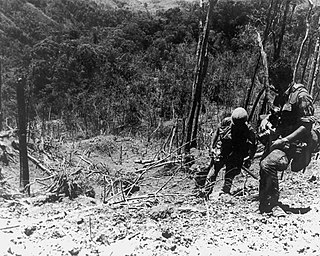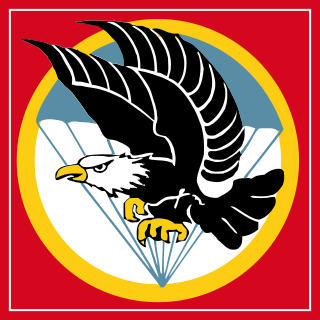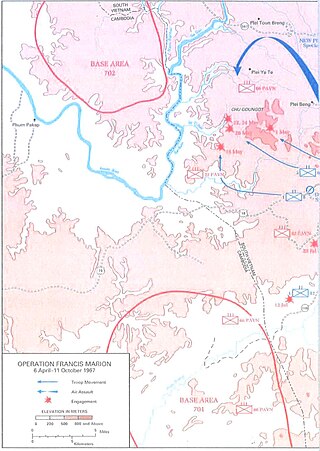
The battle of Dak To in Vietnam was a series of major engagements of the Vietnam War that took place between 3 and 23 November 1967, in Kon Tum Province, in the Central Highlands of the Republic of Vietnam. The action at Đắk Tô was one of a series of People's Army of Vietnam (PAVN) offensive initiatives that began during the second half of the year. PAVN attacks at Lộc Ninh, Sông Bé and at Con Thien and Khe Sanh,, were other actions which, combined with Đắk Tô, became known as "the border battles". The post hoc purported objective of the PAVN forces was to distract American and South Vietnamese forces away from cities towards the borders in preparation for the Tet Offensive.

The Battle of Ia Drang was the first major battle between the United States Army and the People's Army of Vietnam (PAVN), as part of the Pleiku Campaign conducted early in the Vietnam War, at the eastern foot of the Chu Pong Massif in the central highlands of Vietnam, in 1965. It is notable for being the first large scale helicopter air assault and also the first use of Boeing B-52 Stratofortress strategic bombers in a tactical support role. Ia Drang set the blueprint for the Vietnam War with the Americans relying on air mobility, artillery fire and close air support, while the PAVN neutralized that firepower by quickly engaging American forces at very close range.

The Battle of Hamburger Hill was fought by US Army and Army of the Republic of Vietnam (ARVN) forces against People's Army of Vietnam (PAVN) forces during Operation Apache Snow of the Vietnam War. Though the heavily-fortified Hill 937, a ridge of the mountain Dong Ap Bia in central Vietnam near its western border with Laos, had little strategic value, US command ordered its capture by a frontal assault, only to abandon it soon thereafter. The action caused a controversy among both the US armed services and the public back home, and marked a turning point in the U.S. involvement.

The Battle of Gang Toi was fought during the Vietnam War between Australian troops and the Viet Cong. The battle was one of the first engagements between the two forces during the war and occurred when A Company, 1st Battalion, Royal Australian Regiment struck a Viet Cong bunker system defended by Company 238 in the Gang Toi Hills, in northern Bien Hoa Province. It occurred during a major joint US-Australian operation codenamed Operation Hump, involving the US 173rd Airborne Brigade, to which 1 RAR was attached. During the latter part of the operation an Australian rifle company clashed with an entrenched company-sized Viet Cong force in well-prepared defensive positions. Meanwhile, an American paratroop battalion was also heavily engaged in fighting on the other side of the Song Dong Nai.

Phase Two of the Tet Offensive of 1968 was launched by the People's Army of Vietnam (PAVN) and Viet Cong (VC) against targets throughout South Vietnam, including Saigon from 29 April to 30 May 1968. The May Offensive was considered much bloodier than the initial phase of the Tet Offensive. U.S. casualties across South Vietnam were 2,169 killed for the entire month of May, making it the deadliest month of the entire Vietnam War for U.S. forces, while South Vietnamese losses were 2,054 killed. PAVN/VC losses exceeded 24,000 killed and over 2,000 captured. The May Offensive was a costly defeat for the PAVN/VC.

The 22nd Division of the Army of the Republic of Vietnam (ARVN) was part of the II Corps that oversaw the region of the Central Highlands north of the capital Saigon. The 22nd Division was based in Ba Gi near the south central coast.

The Vietnamese Airborne Division or VNAD was one of the earliest components of the Republic of Vietnam Military Forces. The Vietnamese Airborne Division began as companies organized in 1948, prior to any agreement over armed forces in Vietnam. After the partition of Vietnam, it became a part of the Army of the Republic of Vietnam. This division had its distinct origins in French-trained paratrooper battalions, with predecessor battalions participating in major battles including Dien Bien Phu and retained distinct uniforms and regalia. With the formation of an independent republic, the colonial paratroopers were dissolved, however regalia and aesthetics alongside the nickname "Bawouans" would be retained.

The 3rd Battalion, 319th Field Artillery Regiment is the field artillery battalion that directly supports the 1st Brigade Combat Team, 82nd Airborne Division. Known as the "Gun Devils", 3–319th AFAR has participated in battles from World War I to the current day, and is one of the most highly decorated field artillery units in the United States Army. The battalion's mission is "3-319th AFAR stands ready to deploy worldwide within 18 hours of notification, execute a parachute assault and conduct full-spectrum operations. Specifically, the battalion will provide responsive lethal and nonlethal fires in support of forcible entry and airfield seizure, and integrate and synchronize the effects of fires to achieve the 1BCT commander's intent."

The 173rd Airborne Brigade is an airborne infantry brigade combat team (IBCT) of the United States Army based in Vicenza, Italy. It is the United States European Command's conventional airborne strategic response force for Europe.

Operation Hawthorne took place near the village of Tu Mơ Rông, Kon Tum Province, South Vietnam from 2 to 21 June 1966.

Ben Het Camp is a former U.S. Army and Army of the Republic of Vietnam (ARVN) base northwest of Kon Tum in the Central Highlands of Vietnam. The camp was notable for being the site of a tank battle between the U.S. Army and the People's Army of Vietnam (PAVN), one of the few such encounters during the Vietnam War.
The Battle of Thượng Ðức was fought during the Vietnam War from 29 July to 11 November 1974.
Operation Marauder was an operation conducted by the 173rd Airborne Brigade and the 1st Battalion, Royal Australian Regiment in the Plain of Reeds, Mekong Delta, lasting from 1 to 8 January 1966.

Operation Silver City was an operation conducted by the 1st Brigade, 1st Infantry Division and the 173rd Airborne Brigade in Biên Hòa Province, lasting from 7 to 23 March 1966.

Operation Francis Marion was a 4th Infantry Division and 173rd Airborne Brigade operation that took place in Pleiku, Darlac and Kon Tum Provinces, South Vietnam, lasting from 6 April to 11 October 1967.

Operation Bolling was a search and destroy and security operation conducted during the Vietnam War by the U.S. 503rd Infantry Regiment in Phú Yên Province, South Vietnam from 19 September 1967 to 31 January 1969.
Phase III of the Tet offensive of 1968 was launched by the People's Army of Vietnam (PAVN) and Viet Cong (VC) from 17 August to 27 September 1968. The offensive was divided into two waves of attacks from 17 to 31 August 1968 and from 11 to 27 September of that same year.
The Battle of Quang Duc took place from 30 October to 10 December 1973 when North Vietnamese forces attempted to occupy part of Quang Duc Province to expand their logistical network from Cambodia into South Vietnam. While the North Vietnamese attacks were initially successful they were eventually forced out by the South Vietnamese.
Operation Washington Green was a security and pacification operation during the Vietnam War conducted by the 173rd Airborne Brigade in Bình Định Province from 15 April 1969 to 1 January 1971.
Operation MacArthur was a United States Army military operation in the Central Highlands of South Vietnam from 12 October 1967 to 31 January 1969. The early phases of the operation encompassed the Battle of Dak To from 3 to 23 November 1967.














